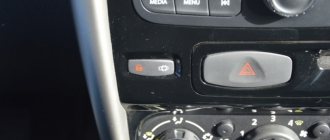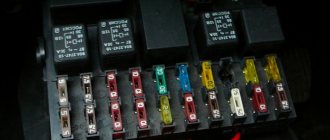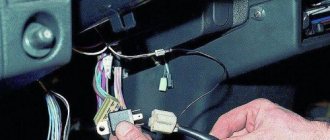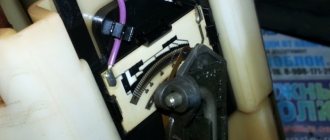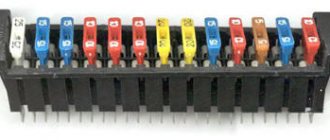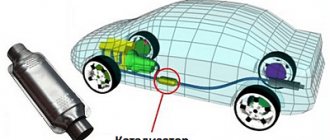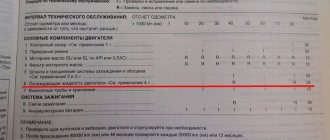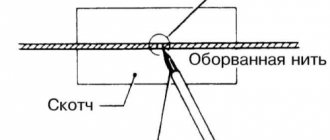Such a malfunction, especially in the summer, can create many problems for the driver. Due to overheating of the coolant, the power unit of the machine can be damaged. To continue further movement, it is necessary to wait for some time for it to cool down, which leads to long delays, delays and other complications. In many cases, malfunctions can be fixed on your own; here are some useful tips for this.
Signs of trouble
The main indicator of the occurrence of such a problem is the steady movement of the temperature indicator arrow to the right into the red sector zone. This can happen for many reasons, but today we will consider only one, when the cooling system fan does not turn on. If this symptom appears, you should stop driving and try to find out why the fan is not rotating.
This device is turned on after the temperature sensor, which is installed in the area of the thermostat, is triggered (a thick tube from the main radiator also fits there). The principle of its operation is that when the coolant temperature reaches 101 degrees, its contacts close and supply voltage is supplied to the fan motor. You can check the electric motor quite simply; to do this, with the ignition on, you should close the wire contacts on the connector of this sensor. If the blades begin to rotate, the motor is working properly.
What else do they pay attention to?
In addition to the sensor, the operation of the fan motors is controlled by the electromagnetic relay K1. Its power circuit is protected by fuse F1, which is rated at 15 Amps. They can be found in the mounting block, in its lower part. The serviceability of the fuses can be checked with a car tester or replaced with known good ones. The relay can also be checked by installing another one, but in this case the contacts of the temperature sensor must be closed, in which case the blades will rotate when the ignition is turned on.
Also pay close attention to the condition of the connector contacts and relay legs. Their oxidation leads to loss of conductivity and the inability to supply power to the fan motors. The serviceability of the temperature sensor can be checked using a thermometer; it should measure the temperature of the liquid more than 100C. It should be installed in the expansion tank and the coolant should be heated. At a temperature of 101 degrees, the fan motor turns on, and at 97 degrees, the fan motor turns off.
Signs of a malfunctioning Lada Granta cooling fan
The temperature needle, without stopping, moves towards the red zone, of course, this happens for other reasons, but today we are looking at the cooling fan.
If a sign of an overheating car appears, you need to stop driving and try to find out the cause of this problem. The cooling fan on Grant turns on after the temperature sensor, which is located near the thermostat, gives a signal.
The sensor works very simply; when the temperature reaches 101 degrees, the contacts close and the fan turns on.
The cooling fan motor can be checked by shorting the wire contacts at the cooling sensor connector. The ignition must be turned on. If the fan starts working, then the cooling motor is working and you need to look in other places.
The next thing to check is relay K1 and fuse F1 (15A).
You can check by installing a working relay and fuse. And if necessary, replace with new ones. You need to take a closer look at the fan relay, since the contacts and legs of this element often oxidize. Which leads to cooling fan failure. Well, that's all, we looked at the main reasons why the cooling fan does not work on a Lada Granta car.
Temperature sensor malfunction
The reason that the liquid in the cooling system, which serves as an air conditioner for the car's power plant, does not heat up or overheats is due to the failure of the temperature sensor.
Often signs of such a malfunction are:
- Stopping the flow of warm air into the car interior, which occurs due to the cessation of fluid flow into the heater.
- Dark, almost black smoke comes out of the exhaust pipe. This indicates engine detonation, which was a result of overheating.
- Engine power drops sharply.
Many drivers quickly stop the car when it overheats and turn off the engine. In fact, an immediate stop of the machine is required only if the tightness of the system is broken and liquid pours out of it. In other situations, the driver must perform the following actions:
- turn on the heating to maximum so that the fluid temperature drops and the engine cools down quickly;
- drive smoothly to the side of the road;
- Let the engine idle for 2-3 minutes with the heating system on.
Read also: Automag club card number
After this, the engine must be turned off and allowed to cool for 20 minutes. After this, you need to measure the fluid level in the cooling system and add it if necessary. Immediately after the engine is turned off, you cannot open the radiator cap, as you can get burned from contact with the liquid. If the fluid level is normal, then the cause of overheating must be determined by diagnostics. To do this you will have to visit a car service center.
New generation Lada
The engine of any car, including the Lada Priora, is a rather complex unit consisting of various mechanisms and systems. The stable operation of the engine is influenced by many factors, including temperature.
If the thermal conditions of the power unit are insufficient, this will affect the quality of formation of the fuel mixture in the cylinders. And when the thermal conditions are higher than required, this can lead to jamming of the cylinder-piston group, serious damage and lengthy and expensive repairs.
Why the engine cooling fan does not turn on on LADA
30 July 2020 LadaOnline 40 276 9
A malfunction of the cooling system fan is one of the reasons for engine overheating. There can be many reasons for this. In this article, we will look at an algorithm that you can use to determine with your own hands why the engine radiator fan is not working.
The instructions for Lada XRAY and Vesta are separate. Next we will talk about Lada Priora, Kalina, Granta, Largus and Niva 4x4 cars.
Video “How to properly replace the thermostat on a Lada Kalina?”
If the problem of a non-functioning sensor in a Lada Kalina car lies in the failure of the thermostat, then this unit will also need to be replaced; detailed instructions for replacing it at home are presented below (the author of the video is Alexey Golubkov).
The engine cooling fan stops turning on and the temperature arrow on the dashboard goes into the red zone. Replaced with a new one: thermostat, pump, temperature sensor on the thermostat, expansion tank cap. The thermostat opens as expected at 85 degrees. I checked all the cooling system pipes for integrity, but the problem did not go away. The fan is obviously working, because when the plug is disconnected from the temperature sensor in the thermostat, the fan starts working. The car is 2009 with air conditioning and gas equipment installed. What could be the problem? Please tell me!
If the cooling fan does not work
Procedure:
1. Make sure that the fan blades rotate without difficulty (nothing is in the way).
2. Check fuses and relays (see mounting block for Lada XRAY, Vesta, Largus, Granta, Kalina, Priora, Lada 4×4).
3. Check the operation of the thermostat (on a warmed-up car, the lower radiator pipe should be hot) and the engine cooling system as a whole (the problem may be in the expansion tank cap).
4. Disconnect the engine cooling fan connector (clean the contacts) and connect it directly to the battery (if the fan turns on, the reason is in the power circuit, if it doesn’t turn on, there is a malfunction in the electric motor).
5. Check the coolant temperature sensor (DTOZH).
6. Open circuit. First of all, you should clean the contacts in the connectors. If this does not help, check the wiring (see electrical diagrams for Lada XRAY, Vesta, Largus, Granta, Kalina, Priora, Niva 4×4).
7. The problem is with the ECU firmware. In some cases, flashing the ECU unit helps solve the problem of turning on the fan.
The main reasons why the cooling system fan did not turn on (survey among LADA car owners):
- faulty DTOZH (42%);
- wiring break (10%);
- fuse blown (8%);
- fan motor malfunction (6%);
- another reason (34%).
Rated operating temperature of the VAZ 21126 Priora engine
To find out what the normal operating temperature is in the Priora 16 class injection engine, just study the factory technical documentation. It states that according to the International Motor Vehicle Manufacturers Convention, the operating temperature in gasoline engines with an injection power system should be within 90 degrees. VAZ 21126 engine must operate in the temperature range from 87 to 103 degrees .
Read also: Nissan from Fast and Furious 2 photos
This contributes to the normal correct operation of the power system, maximum engine performance, and in addition, the content of harmful substances in the exhaust gases complies with Euro3 standards that were current at that time. And the engine power, as practice shows, remains within the nameplate limits - about 98 forces at 5.5-5.6 thousand rpm. Again, judging by the reviews, and based on practice, fuel consumption during overheating can increase by 15-25%, and when operating the engine at coolant temperatures below 85 degrees, consumption increases by 10-18%.
If the cooling fan runs constantly
Possible reasons:
- A break in the coolant temperature sensor or its circuits.
- Faulty cooling fan relay.
- The ECU is faulty.
Have you ever encountered a situation where the engine cooling fan did not work? In the comments we leave questions about this car malfunction, as well as our solutions and recommendations for this problem.
By the way, did you know that the engine cooling system of Lada Granta and Kalina 2 differs from the system that was used on previous generation LADA cars.
Keywords: cooling system Lada Granta | cooling system for Lada Kalina | cooling system for Lada Priora | cooling system for Lada Largus | 4x4 cooling system | cooling system for Lada Vesta | cooling system lada xray | universal article
.. 41 42 43 44 ..
Lada Granta for training (2019). The radiator cooling fan does not work (does not turn on) - reasons, troubleshooting
- the thermostat is faulty
— blown, check the fuse that controls the fan
— the fan switch sensor (DVS) is faulty
- faulty fan relay
- faulty fuse box
- power cable break
— break in the output path to the radiator sensor wire
— the gasket under the head is burned out (coolant does not pass into the cylinder)
Problems with the cooling fan usually occur in used cars with decent mileage. This breakdown manifests itself in different ways; the fan may not work stably, may turn on late or not turn on at all.
There can be quite a few reasons why the fan does not turn on, from a banal fuse blown to more complex problems associated with a malfunction of the thermostat or problems with the electrical wiring of the vehicle's on-board network.
If the engine boils, but the fan still does not turn on, then the first thing that comes to mind for most motorists is problems with the fan wiring. However, very often the wiring has nothing to do with it, and the real reason lies precisely in the thermostat. The device designed to monitor the temperature of the coolant (coolant) may fail or simply jam, after which the coolant stops circulating through the radiator, as a result, the radiator sensor does not work, and the fan itself does not turn on.
Then check the fuse that controls the fan; if the fuse is blown, replace it with a intact one. If the cause is not a fuse, you need to check the fan itself directly. The power wires come to it; often they simply crumble or break off due to age. Alternatively, the reason may lie in the plug, so if everything is fine with the wiring, turn off the power to the fan and check the plug for a malfunction. Connect power to the fan directly, for example, from the battery; if the fan does not react in any way, we conclude that the fan is faulty.
Check the fan switch sensor (FSW) located on the radiator. To do this, you need to disconnect the plugs and then connect them together; if the fan does not work, the DVV is faulty and requires replacement. It is necessary to connect the wire going to the fuse box directly to ground (usually white with a black stripe). If after this the fan starts working, we can conclude that the second black wire has broken; try to find the break and check whether its connection to ground is reliable. After that, we connect the two wires together and see what happens, if the fan turns on, then the problem was a bad connection.
Check the fan relay, it is quite possible that the problem is there. In order to find out, simply replace it with an adjacent relay, then connect the radiator sensor wires to each other, see above. The fan will turn on - the problem is a faulty relay.
Next, you need to check the voltage to see if it is supplied to the fan through the fuse box. To do this, take a piece of wire and install it in the relay connectors; if the fan is working, the reason why the fan does not work is in the fuse box. It is likely that voltage is not being supplied to the fan relay. To check this, you can use the “old-fashioned” method. We take a light bulb that will serve as a “control”. If there is no light bulb, just lightly strike the other end of the wire against ground, if you see a spark, there should be no problems, most likely this is not the reason. If you don’t see a spark, most likely there is no voltage in this connector, that is, there is a break in the track in the fuse block. If, after checking all of the above, you find the reason why the radiator fan does not turn on, you only have to check one wire - the radiator sensor wire. To do this, you must remove the switch as it does not allow access to the fuse box plugs. This means we remove the plug from the fuse block and check the radiator sensor wire for a break. We check as follows: connect the wire to the “+” terminal of the battery, install the other end into the connector of the chip. Next, remove the plug from the sensor and connect the light bulb. If there is no light bulb, make a “teal” to ground. If there is no voltage, most likely this wire is broken. If the fan does not turn on, the reason may be completely unexpected, for example, a burnt gasket under the head. Switching on does not occur for the reason that the coolant does not enter the cylinder, while gases from the cylinder penetrate into the coolant, creating an effect known as an air lock. This plug prevents normal coolant pumping. How to understand that you have a burnout? It is enough to look into the expansion tank, if bubbles come out of it every now and then during operation - you have a burnt gasket, or there is a crack in the cylinder.
WHAT TO DO IF THE RADIATOR COOLING FAN DOES NOT WORK
Making sure that the radiator cooling fan has failed and is not working is quite simple. To do this, you need to start the car engine and let it idle for some time. When the dashboard shows that the coolant temperature is approaching the critical zone, the sensor will notify the radiator fan so that it starts working. At this moment, the driver will hear additional noise from under the hood, and when he opens it, he will see that the fan impeller is spinning near the radiator. If the coolant temperature has reached a critical value, and the radiator cooling fan does not turn on, you need to find out why this is happening. The following are the main reasons why the radiator cooling fan does not work: Problems with the electric motor. If the electric motor fails, its rotor will not spin, and accordingly, the impeller will not rotate. You can check the performance of the electric motor by connecting it directly to the battery. To do this, you will need to take two wires, connect them to two battery terminals and two electric motor terminals. If the fan does not spin when connected directly to the battery, we can conclude that the electric motor needs to be replaced; Problems with the sensor. If the sensor is unable to detect the coolant temperature and transmit a signal to turn on the electric motor, it will need to be replaced. To make sure that it is not working, you need to disconnect two wires from it and short them together. If the electric motor starts to spin the impeller, this will indicate that the sensor is faulty and needs to be replaced; There is no tension. The third and most common reason for a non-working radiator cooling fan is the lack of voltage in its power supply circuit. If there is a break in the wires or a fuse fails, the circuit will be de-energized. To make sure that this problem exists, you need to “ring” the wires and check the fuses. If the radiator cooling fan does not turn on, it is quite easy to find the cause of the problem; just perform the checks described above. RADIATOR COOLING FAN IS NOT WORKING: HOW TO USE THE CAR
If the radiator cooling fan fails, it is better to immediately figure out the cause and fix the problem. But the problem can arise suddenly, and the driver must know the basic rules of how to drive a car with the fan turned off to prevent the engine from overheating: Try turning on the forced operation of the fan from the battery; If the fan is not forced, you should drive at a constant speed of about 60 kilometers per hour or higher so that the oncoming air flow cools the fluid on the radiator without the help of a fan. It is also recommended to turn on the heating system in the car interior so that some of the heat from the coolant escapes into the cabin. Remember that if the coolant is overheating, it is better to stop and wait a while for it to cool, rather than continue driving the vehicle and risk overheating the engine.
The cooling fan turns on on a cold engine: the main reasons and solution to the problem
As you know, various malfunctions of the engine cooling system do not allow the engine to reach the optimal temperature regime. The engine may overheat, which can lead to rapid breakdown, or remain cold, that is, not reach operating temperature.
Modern cars use a combined internal combustion engine cooling system: liquid and air cooling. By liquid we mean the circulation of antifreeze or antifreeze through special channels in the cylinder block and cylinder head of the engine.
The coolant circulates thanks to a pump. For additional cooling, the coolant can also circulate in a small circle (inside the engine) and in a large circle, that is, through the radiator.
Air cooling is implemented using a fan, which removes excess heat by supplying an air flow into the engine compartment to blow over the engine. The specified fan is activated when the heating of the unit is sufficiently high.
However, quite often drivers are faced with the question of why the cooling fan turns on on a cold engine, the engine fan turns on in winter or spins constantly. In this article we will talk about the reasons why the cooling fan operates on a cold engine, the engine cooling fan does not turn off, or the specified fan does not work correctly.
The fan runs on a cold motor: causes, diagnosis, repair
Let's start with the fact that this problem can clearly indicate both a malfunction of the liquid cooling system and a malfunction of the fan itself. In any case, we are talking about a breakdown that cannot be ignored, since the risk of overheating of the internal combustion engine significantly increases.
For a better understanding, it is necessary to superficially consider the principle of operation of the fan on most modern cars. The airflow is activated by a special sensor located at the bottom of the radiator. Also, many cars use a separate engine cooling fan control unit. There are also models in which the ECU itself is responsible for turning on the fan, but this design is rarely used.
So, after heating the coolant to an average temperature of about 100 degrees Celsius, the sensor or control unit closes the electrical circuit. After this, the fan turns on, improving engine cooling. When the coolant temperature drops to the required value, the circuit opens and the blowing stops.
As you can see, the fan should not work on a cold engine. So, to determine why the fan turns on early, for injection cars with an OBD II diagnostic connector, it is recommended to start with computer diagnostics of the car. The fact is that the ability to read error codes from the ECU allows you to more accurately determine the cause of the malfunction.
We also note that in cases where the control unit detects errors in the cooling system, the fan can spin immediately after turning on the ignition, even on a cold internal combustion engine. This feature is found only on some models and is, in fact, protection against overheating of the power unit, since a constantly running fan reduces the temperature.
After repair, in this case you will also need to reset the errors. To erase an error from the ECU, on some models it is enough to remove the terminal from the battery for a couple of minutes, while on others the reset is carried out using diagnostic equipment.
Common cooling fan problems
Now let's look at common problems that are associated with the cooling system and the fan itself.
- First of all, in many cases the contacts of the air system sensor short-circuit. In this case, the air blower is activated immediately after the ignition is turned on.
During the diagnostic process, the resistance at the outputs is measured on a cold sensor using a multimeter. Deviations from the norm will indicate the need to replace the element.
- There is not enough coolant in the liquid system. In this case, the fan is triggered due to the fact that a small amount of antifreeze or antifreeze heats up very quickly. In other words, the fan is working properly and starts naturally.
As a rule, leaks or decreased coolant levels in the expansion tank are the main cause. Please note that antifreeze is a mixture of concentrate and water. Water gradually evaporates from the system, causing the level to drop. For this reason, it is recommended to periodically check and add fluid according to special marks.
If there is little coolant in the system, heating occurs quickly. It is also noteworthy that the actual temperature of the liquid is very different from the temperature of the internal combustion engine. It often happens that a cold engine is started, the temperature arrow on the dashboard has not yet risen, but the fan is already working because the liquid is too hot. To solve the problem, it will be enough to fill in antifreeze and remove air plugs from the cooling system.
- The fan shorts to ground because the wire may not be screwed securely enough, the contact point has been damaged, etc.
In this case, the fan can short-circuit to the battery and run non-stop. In such a situation, you need to check all contacts, wiring and other elements. Wires must be securely insulated and properly connected.
- The fan sensor, which is integrated into the thermostat housing, has failed. Quite a lot of modern cars are designed with a thermostat, which is combined with a fan control sensor.
This solution allows for flexible control of the engine cooling system. However, if there is a problem with the temperature sensor in the thermostat housing, the fan may start running without turning off. The fact is that the control unit begins to receive incorrect signals about how the thermostat works. As a result, the emergency mode is activated, the fan turns on and runs constantly.
In such a situation, you need to check the sensor with a multimeter. Normally, on a cold engine its resistance is infinite, in other cases the indicator should be 100 - 500 Ohms. Deviations in the readings from the norm will indicate that the sensor needs to be replaced with a new one or a known good one.
- The outside air temperature sensor has failed. This problem occurs on some cars that are equipped with ambient temperature sensors. If the temperature is above the permissible limit, then these sensors will turn on the fan.
This solution allows for more efficient cooling of the power unit, especially on cars that have a powerful forced-internal combustion engine and several radiators. On such units, the fan can be turned on in the warm season even on a cold internal combustion engine to protect against engine overheating.
- After turning on the car air conditioner, the fan is constantly running. Note that on some models this fan operation is normal.
If we talk about malfunctions, on most modern cars the cooling system is closely connected with the air conditioning system. It is for this reason that contamination of the air conditioner radiator can cause the engine cooling fan to constantly operate at maximum speed.
To solve the problem, external cleaning of the air conditioner radiator and cooling system radiator may be required. The fact is that these radiators are located next to each other, dirt, dust and fluff accumulate between them. Removing such a “coat” allows you to normalize the operation of the air conditioning and engine cooling system, get rid of frequent fan starts and increased noise during its operation.
- Problems with wiring and electrical contacts. Regardless of how the fan is controlled, contacts are a common cause of problems.
Oxidation of contacts or damage to wiring, insufficient fixation at connections and other defects lead to short circuits, transmission of incorrect signals to control units, etc. As a result, the overheating protection mode is activated by constantly rotating the fan, etc.
In order to avoid such a situation, experienced drivers recommend cleaning contacts before the onset of winter and summer for preventive purposes. Treatment with special lubricants and protective compounds is also actively practiced.
What's the result?
As you can see, the internal combustion engine itself and its systems require regular maintenance. As for the cooling system, it is also no exception and requires special attention.
If the driver notices that the cooling fan has started to work at maximum speed all the time or has stopped turning off in a timely manner, then the first thing you should do is check the antifreeze level, the functionality of the pump and thermostat.
It is also necessary to take into account that the reason for such fan operation may be a clogged cooling radiator or too high outside air temperature, shorted contacts, etc. We should not forget that the fan can constantly spin on a cold engine when the air conditioner is running.
Source: https://KrutiMotor.ru/ventilyator-ohlazhdeniya-srabatyvaet-na-holodnom-dvigatele/
Table of operation of the cooling fan on the Lada Granta depending on temperature and ECU types
In order to find out at what coolant temperature the fan on your car turns on, just look at the table below and find your type of ECU and car.
The following two tabs change content below.
- About the expert:
Expert on Renault cars I own a Renault Megane 2, before that there were Citroens and Peugeots. I work in the service area of a dealership, so I know the car inside and out. You can always contact me for advice.
| Cable throttle system | 8-valve internal combustion engines | 16 valve internal combustion engines | 8-valve internal combustion engines | 16 valve internal combustion engines |
| January 7.2 software A\I201CO56\57\58 T=101 degrees | B101CR01 T=103 degrees | B173CR03 T=101(1) degrees T=105(2) degrees | А\I303CD04\CE05\CF06 Т=101(1) degrees Т=105(2) degrees | A\I373CA01\02 T=101(1) degrees T=105(2) degrees |
| Bosch 797 software B1C02Q05 T=103 degrees | В102СR06 T=103 degrees | B174CR03 T=101(1) degrees T=105(2) degrees | ||
| Bosch 797+ T=103 degrees | B104CR02 T=101(1) degrees T=105(2) degrees | B11KSS01\B13KSS02 T=101(1) degrees T=105(2) degrees |
Cooling fan diagnostics
In order to diagnose the performance of your fan, you just need to disconnect the connector from the thermostat sensor. In this case, the sensor must work forcibly.
Changing values
You can change the factory switching settings through the system of almost any on-board computer (STATE or MULTITRONICS), the recommended values should not be lower than 95-97 degrees.
Cooling system malfunctions
Cooling system diagram
Read also: Wheel sizes for classic VAZs
The system is structurally simple, but it needs to be constantly monitored. First you need to know what the operating temperature of the engine of the Lada Priora is. For this car it is 90˚С. The engine temperature is displayed on a sensor located on the dashboard. While driving, you should constantly monitor its readings. If they exceed 100˚C, you should pay attention to whether the fan turns on.
The problem when the fan does not turn on on the Priora may be hidden within itself, or the cause of overheating may be the fan switch on sensor.
If it is found that the fan does not turn on when the permissible temperature is exceeded, first of all you should check the connection of the wires to it. It often happens that one of the terminals falls off, which is why the fan does not turn on.
If the wiring is in order, it is worth checking its operation and finding out whether the fan switch is activated. To do this, you need to start the power unit and disconnect the wires from the temperature sensor installed on the engine. When the wires are disconnected, the forced cooling should start working; if this does not happen, there is most likely a problem with the drive motor.
If, when the wires are disconnected, it starts to work, the fan switch sensor has probably failed. It is quite possible that it incorrectly perceives information about the temperature of the power unit and therefore does not turn on. This problem is solved by replacing the fan switch sensor.
After the sensor is replaced, you should again check whether forced cooling of the radiator turns on and at what temperature this occurs. To do this, you need to start the engine and set the speed to medium. When the optimal thermal mode is reached, you need to continue to hold the speed until the temperature rises and it turns on. If the operation occurs at a value of 97-100˚C, we can assume that the cooling system on the Priora is working properly.
What is the cooling system on the Lada Granta
On the VAZ-2190 or simply Lada Granta, although a modernized engine cooling system was created and installed, the design similarity with the predecessor Lada Kalina still remained.
Since the cooling system in Grants, as on all Russian cars, is a closed type system, the liquid through it is evenly distributed over all its closed areas.
It is worth noting separately that in the new Lada Granta models, the developers removed the engine (coolant) temperature indicator from the instrument panel. Instead, a special warning lamp is provided - signaling the maximum temperature of the antifreeze and the moment the radiator fan turns on.
Replacing the fan switch sensor on a VAZ 2101-VAZ 2107
Welcome! The fan switch sensor is far from the last sensor in a car, because thanks to it, the radiator fan turns on when the engine temperature reaches a certain point, but not on all cars, for example, if we take the very first VAZ 2101, they did not have this sensor at all , later, of course, it appeared, but closer to the removal of this car from the assembly line, but these cars almost never warmed up, since their fan was spinning constantly, but if the cooling system of the car is fully operational, then the cars with a sensor thanks to which turn on the fan will also not heat up, and it will warm up much faster because the fan does not spin and allows the engine to heat up very quickly.
Note! To replace this sensor, take with you a set of tools: In this set you must have a wrench set to “30”, with its help you will turn out the sensor, in addition to it, stock up on a large container (a 10 liter basin will be perfect), but although if you do everything quickly, you won’t need any container, in general, a little later (As you read the article) we will explain to you why you need a basin and what to do if you don’t want to get it dirty!
Where is the fan switch located? Let's start with the fact that you need to look for it in the engine compartment of the car, opening the hood immediately look for the radiator (It is indicated by a blue arrow in the large photo), the sensor will be screwed into this radiator (the sensor is indicated by red arrows), but only as you see in the photo below, the wires from the sensor are disconnected, respectively, they will be connected and you will see a slightly different picture, besides this, as you can see, all the radiators have a completely different shape and some have holes for the sensor in the lower left part (see large photo), and for someone in the lower right part (see small photo), if you have it in the right, then the sensor will be located just above the lower pipe, which is indicated by a blue arrow, but on an aluminum radiator this sensor is generally located at the very bottom under the pipe and not above it , so look for it, in fact, it always has one shape, and you can see its shape perfectly in the photographs below.
When do you need to change the fan switch sensor? It is replaced when it fails, namely, if the radiator fan stops turning on, you will immediately understand this if your car heats up to a high temperature and the fan still does not turn on, although in this case the electric motor of the fan may also be to blame, but all this (the serviceability of the sensor also means the fan motor) is easy to check, just grab with your hands in this case both wires that are connected to the sensor (These are essentially terminals, see the photo below) and disconnect them, and when they come out, bridge them together and hold it, it’s better to do this with gloves on and we don’t advise you to handle the terminals, just grab the wires themselves and jumper the ends of the terminals, after that the cooling fan should start working immediately (In this case, the sensor needs to be changed), and if the fan doesn’t turn on, then either you have a problem with the electric motor or something with the wiring that is connected to the sensor, but basically the fan always turns on and this indicates that the sensor has stopped working, by the way, if this sensor breaks in your traffic jam, then you can safely disconnect these two wires from it and rewind them with insulating tape so that they fit together, after which your fan will work constantly, or rather until you open the terminals. (Ignore the arrows in the photo below)
New Lada: Test LADA Granta Cross: restyling of Kalina Cross
Note! When you connect the wires to each other, do not forget to turn on the ignition on the car and what else, if suddenly when you connect the wires your fan does not work, check the fuse that controls the electric motor, it may have burned out and needs to be replaced!
